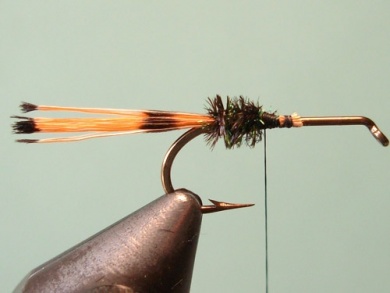The Royal Trude is a classic fly that remained in time. The down wing provides fish with a different silhouette than most attractor flies. It is a universal pattern that could be used everywhere.This fly is credited to Carter Harrison of Chicago, it is said he created it as a joke in 1906 at the Ida Ver más...The Royal Trude is a classic fly that remained in time. The down wing provides fish with a different silhouette than most attractor flies. It is a universal pattern that could be used everywhere.This fly is credited to Carter Harrison of Chicago, it is said he created it as a joke in 1906 at the Idaho Trude Ranch, using red yarn from a rug for the body and hair from a red spaniel for the wing. Nevertheless, the pattern became very successful later on.The Royal Coachman, in its three kinds (traditional, wet and streamer), set the bases for the ancient series of Royal flies that have left a strong mark on fly tiers from around the world for over a hundred years. The Trude is another fly that takes the body of the Coachman and adds some variations, like its down-wing that allows us to fish it dry or as a wet or streamer fly.Here are the tying instructions; it is a fly that can be used to fish in many different situations with great results.
Deslice el cursor sobre la imagen para visualizar la mosca con zoom.
Deslice el dedo sobre la imagen para hacer zoom.

Listado de materiales
MaterialsHook: TMC 100 # 8 to 16Thread: UNI 8/0, blackTail: Golden pheasant tippetsBody: Peacock herl, red floss, peacock herlWing: White calf tail or body hairHackle: A strap of white deer hair
Pasos
Paso 1
Place the golden pheasant tippets to make the tail
Paso 2
Tie 3 or 4 peacock herl fibers at the base of the tail
Paso 3
Wrap the peacock fibers (with 3 or 4 turns), shaping the first segmentTrim
Paso 4
Tie the red floss next to the first peacock segment
Paso 5
Wrap the red floss to shape the mid section of the body
Paso 6
Tie 3 or 4 peacock herl fibers next to the floss
Paso 7
Wrap the peacock fibers (with 3 or 4 turns), shaping the second segmentTrim
Paso 8
Tie a bundle of white calf tail or body hair to build the wing of the fly
Paso 9
Tie a brown rooster feather. It should be 1 ½ hook gapes
Paso 10
Wrap the rooster feather up to the hook eyeWhip finish and cement










